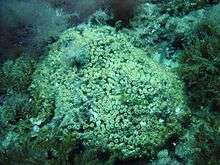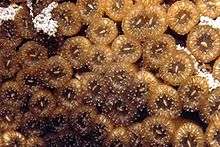Cladocora caespitosa
Cladocora caespitosa, commonly known as cushion coral, is a stony coral of the subclass Hexacorallia.[2] This species forms the only true coral reef in the Mediterranean Sea.
| Cladocora caespitosa | |
|---|---|
 | |
| Scientific classification | |
| Kingdom: | Animalia |
| Phylum: | Cnidaria |
| Class: | Anthozoa |
| Order: | Scleractinia |
| Family: | incertae sedis |
| Genus: | Cladocora |
| Species: | C. caespitosa |
| Binomial name | |
| Cladocora caespitosa (Linnaeus, 1758) | |
| Synonyms | |
| |
Description

The polyps are a clear maroon colour, around 5 mm in diameter and form cushion-shaped colonies, in symbiosis with Zooxanthella algae. They produce deposits of calcium carbonate which form the calciate structures in which they live. It is the largest stony coral in the Mediterranean, reaching up to 50 cm in diameter. C. caespitosa has an average generation length of about 30 years.[1]
Distribution and habitat
This species is endemic to the Mediterranean Sea, where it is attested already in the Upper Pliocene. It is common on rocky seabeds between a few metres and 60 metres in depth. In the marine lagoon of Veliko Jezero, in the marine reserve of Mljet island, Croatia, there is a small coral reef made up of C. caespitosa. This is the only true coral reef in the Mediterranean.[3]

Reproduction
The colonies grow through budding, but the species spreads through the settlement of plankton-like larva on seabed suited to colonisation.
Threats
Cladocora caespitosa is classified as endangered under the IUCN red list, mostly based on recent mass die-offs caused by heat wave events in the Mediterranean.[1]
References
- Casado de Amezua, P.; Kersting, D.; Linares, C.L.; Bo, M.; Caroselli, E.; Garrabou, J.; Cerrano, C.; Ozalp, B.; Terrón-Sigler, A. & Betti, F. (2015). "Cladocora caespitosa". IUCN Red List of Threatened Species. 2015: e.T133142A75872554. doi:10.2305/IUCN.UK.2015-2.RLTS.T133142A75872554.en.
- "Cladocora caespitosa". WoRMS. World Register of Marine Species. Retrieved 30 Oct 2014.
- Kružić, Petar; Požar-Domac, Antonieta (2003). "Banks of the coral Cladocora caespitosa (Anthozoa, Scleractinia) in the Adriatic Sea". Coral Reefs. 22 (4): 536. doi:10.1007/s00338-003-0345-y.
Bibliography
- Trainito, Egidio (2004). Atlante di flora e fauna del Mediterraneo (2004 ed.). Milano: Il Castello. ISBN 978-88-8039-395-5.
- Mojetta A.; Ghisotti A (2003). Flora e Fauna del Mediterraneo. Mondadori. ISBN 978-88-04-38574-5.
- Kružić, Petar; Požar-Domac, Antonieta (2003). "Banks of the coral Cladocora caespitosa (Anthozoa, Scleractinia) in the Adriatic Sea". Coral Reefs. 22 (4): 536. doi:10.1007/s00338-003-0345-y.
| Wikimedia Commons has media related to Cladocora caespitosa. |
External links
- Photos of Cladocora caespitosa on Sealife Collection
